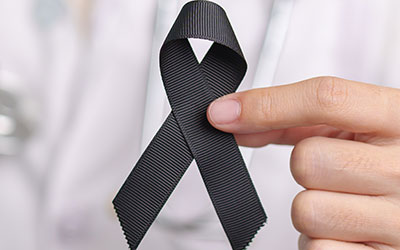Interesting Facts About Skin Cancer
 Skin cancer is the most preventable type of cancer in the nation, according to the Centers for Disease Control and Prevention. There is a lot of information available about skin cancer, but these are some facts and statistics that may surprise you.
Skin cancer is the most preventable type of cancer in the nation, according to the Centers for Disease Control and Prevention. There is a lot of information available about skin cancer, but these are some facts and statistics that may surprise you.
Top 5 Facts About Skin Cancer
Top 5 facts about skin cancer include:
- One in five people in the United States will develop skin cancer sometime in their lives.
- U.S. doctors diagnose about 9,500 cases of skin cancer each day.
- In 2024 alone, doctors will diagnose over 100,000 new melanomas, which are a dangerous form of skin cancer.
- Melanoma will have claimed almost 8,300 lives in 2024.
- Women under age 50 have a higher risk of developing skin cancer than their male counterparts; the risk increases in men after age 50 and is twice that for women by age 65.
Important Facts About Skin Cancer Risk Factors
Certain factors increase the risk of skin cancer. Some people have more than one risk factor.
Skin Color Can Increase Risk
People of all ages and skin colors can develop skin cancer, although adults with lighter skin types have a higher risk. Caucasians have a higher risk of developing melanoma, although people of color are less likely to survive this type of cancer – often because it is diagnosed later when it is less responsive to treatment. What’s more, people of color can develop skin cancer in areas that aren’t exposed to the sun, like the palms of the hands and soles of the feet.
Other factors that can increase your risk of skin cancer include:
- More than 50 moles or unusual moles
- A family history of melanoma
- Fair skin, freckles, and blond or red hair
People of All Ages Can Develop Skin Cancer
Melanoma is the second most common form of skin cancer in females aged 15 to 29. The incidence of melanoma is increasing more quickly among females in this age group. Sustaining a bad sunburn during your childhood or teenage years can double your risk of developing melanoma. If you sustain five or more severe sunburns between the ages of 15 and 20, your risk of melanoma increases by 80%, and your risk of nonmelanoma skin cancer increases by 68%.
Interesting Facts About Skin Cancer Detection and Prevention
About half of melanomas are self-detected. We encourage you to regularly check yourself for signs of skin cancer. When checking for warning signs, use the ABCDE acronym. Check for moles that are asymmetrical (A), have irregular or undefined borders (B), blend a variety of colors (C), have a diameter of about ¼ inch or 6mm (D) and grow or evolve over time (E). Women are nine times more likely than men to notice signs of melanoma in others. Women (or anybody) can potentially save their partner’s or friend’s life by checking them for skin cancer.
Facts About Sunscreen and Skin Cancer
Applying sunscreen is one of the best ways to prevent skin cancer, but there is a significant amount of misinformation circulating, especially when it comes to skin cancer.
Sunscreen Does Not Cause Skin Cancer
There is no medical evidence or research that shows sunscreen causes skin cancer. In fact, there is substantial evidence that using sunscreen can reduce the risk of skin cancer. A 2022 study of almost 10,000 people showed that using sunscreen drastically lowers the risk of skin cancer, for example, and a 2016 study of more than 100,000 women found that using sunscreen can reduce the risk of melanoma by 18%.
Sunscreen Protects Against Skin Cancer
Exposure to ultraviolet (UV) rays from the sun and tanning beds can cause skin cancer by damaging the DNA in skin cells. DNA contains the instructions cells need to work correctly, and to replicate. Damaged DNA can cause cells to function and reproduce incorrectly, and this can cause the cells to become cancerous. Sunscreen works by stopping UV rays from reaching the skin.
For Best Protection Against Skin Cancer, Use the Right Sunscreen
Sun Protection Factor (SPF) describes the amount of protection offered by a sunscreen product. SPF is discussed in terms of a number. This number represents the amount of time the skin burns with sunscreen compared to without sunscreen. For example, skin burns 50 times slower with SPF than with nothing. For optimal coverage, use sunscreen that is:
- Broad Spectrum: protects your skin from both types of ultraviolet rays, UVA and UVB
- SPF 30+: Necessary for outdoor activities, such as hiking or riding a bicycle
Key Facts About Tanning Beds and Skin Cancer
Many people enjoy tanning beds because the technology allows them to get tanned skin without having to hit the beach. Though numbers have been decreasing, more than 7 million American adults utilize indoor tanning beds.
Tanning Beds Increase the Risk of Skin Cancer
The lights used in indoor tanning equipment, including tanning beds, emit harmful UVA and UVB radiation. In fact, the amount of radiation they produce is similar to – or even stronger – than that produced by the sun.
Young Adults Have Special Risks
Using tanning beds before the age of 20 raises the risk of melanoma by 47%. The risk increases each time they use a tanning bed. Women under the age of 30 who tan indoors are six times more likely to develop melanoma.
Even People Who Do Not Burn with Indoor Tanning Are at Risk
You don’t need to get sunburned to develop skin cancer from indoor tanning, as the light produced by indoor tanning damages skin cells without burning them.
Facts About Sunburn and Skin Cancer
Sunburn damages your skin cells in ways that increase the risk of skin cancer. In fact, just having skin that burns easily increases your risk of skin cancer.
Just One Sunburn Can Cause Skin Cancer
A single sunburn can cause skin cancer, especially if the sunburned skin blisters. Just one blistering sunburn before the age of 18 nearly doubles the risk of melanoma. Episodes of blistering sunburns before 18 can increase the risk further.
Damage From Sunburns Can Build Up
Sunburns can have cumulative effects, which means the damage builds up in your skin cells over time. The more sunburns you get, the greater your risk of developing skin cancer, including melanoma, basal cell carcinoma and squamous cell carcinoma. Each sunburn increases the likelihood of skin cell mutations, which can lead to these types of skin cancer later on. This highlights the importance of protecting your skin from UV exposure to reduce your risk.
Skin Cancer Specialists at Schweiger Dermatology Group
Now that you know these skin cancer facts and key information about detection and prevention, take care of yourself and also share your knowledge with others. Skin cancer is a serious condition, but with early detection, accurate diagnosis and appropriate treatment, the prognosis for most patients can be positive. To schedule an appointment, call or text us at 844-DERM-DOC/(844) 337-6362 or book online.
Originally posted 05/10/2021. Updated 11/25/2024.
